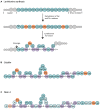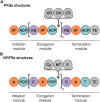Overview of the Antimicrobial Compounds Produced by Members of the Bacillus subtilis Group
- PMID: 30873135
- PMCID: PMC6401651
- DOI: 10.3389/fmicb.2019.00302
Overview of the Antimicrobial Compounds Produced by Members of the Bacillus subtilis Group
Abstract
Over the last seven decades, applications using members of the Bacillus subtilis group have emerged in both food processes and crop protection industries. Their ability to form survival endospores and the plethora of antimicrobial compounds they produce has generated an increased industrial interest as food preservatives, therapeutic agents and biopesticides. In the growing context of food biopreservation and biological crop protection, this review suggests a comprehensive way to visualize the antimicrobial spectrum described within the B. subtilis group, including volatile compounds. This classification distinguishes the bioactive metabolites based on their biosynthetic pathways and chemical nature: i.e., ribosomal peptides (RPs), volatile compounds, polyketides (PKs), non-ribosomal peptides (NRPs), and hybrids between PKs and NRPs. For each clade, the chemical structure, biosynthesis and antimicrobial activity are described and exemplified. This review aims at constituting a convenient and updated classification of antimicrobial metabolites from the B. subtilis group, whose complex phylogeny is prone to further development.
Keywords: Bacillus subtilis group; bacteriocins; biocontrol; biosynthetic pathways; lipopeptides; polyketides; siderophores; volatile.
Figures








Similar articles
-
Classification and Multifaceted Potential of Secondary Metabolites Produced by Bacillus subtilis Group: A Comprehensive Review.Molecules. 2023 Jan 17;28(3):927. doi: 10.3390/molecules28030927. Molecules. 2023. PMID: 36770594 Free PMC article. Review.
-
Nonribosomal peptides and polyketides of Burkholderia: new compounds potentially implicated in biocontrol and pharmaceuticals.Environ Sci Pollut Res Int. 2018 Oct;25(30):29794-29807. doi: 10.1007/s11356-017-9166-3. Epub 2017 May 25. Environ Sci Pollut Res Int. 2018. PMID: 28547376 Review.
-
Identification and classification of known and putative antimicrobial compounds produced by a wide variety of Bacillales species.BMC Genomics. 2016 Nov 7;17(1):882. doi: 10.1186/s12864-016-3224-y. BMC Genomics. 2016. PMID: 27821051 Free PMC article.
-
Bioactive Secondary Metabolites from Bacillus subtilis: A Comprehensive Review.J Nat Prod. 2019 Jul 26;82(7):2038-2053. doi: 10.1021/acs.jnatprod.9b00110. Epub 2019 Jul 9. J Nat Prod. 2019. PMID: 31287310 Review.
-
Antimicrobial Activities of Lipopeptides and Polyketides of Bacillus velezensis for Agricultural Applications.Molecules. 2020 Oct 27;25(21):4973. doi: 10.3390/molecules25214973. Molecules. 2020. PMID: 33121115 Free PMC article. Review.
Cited by
-
Bacillus strain BX77: a potential biocontrol agent for use against foodborne pathogens in alfalfa sprouts.Front Plant Sci. 2024 Jan 19;15:1287184. doi: 10.3389/fpls.2024.1287184. eCollection 2024. Front Plant Sci. 2024. PMID: 38313804 Free PMC article.
-
Potentiality of Beneficial Microbe Bacillus siamensis GP-P8 for the Suppression of Anthracnose Pathogens and Pepper Plant Growth Promotion.Plant Pathol J. 2024 Aug;40(4):346-357. doi: 10.5423/PPJ.OA.01.2024.0022. Epub 2024 Aug 1. Plant Pathol J. 2024. PMID: 39117334 Free PMC article.
-
Positioning Bacillus subtilis as terpenoid cell factory.J Appl Microbiol. 2021 Jun;130(6):1839-1856. doi: 10.1111/jam.14904. Epub 2020 Nov 20. J Appl Microbiol. 2021. PMID: 33098223 Free PMC article. Review.
-
Bacillus velezensis 83 a bacterial strain from mango phyllosphere, useful for biological control and plant growth promotion.AMB Express. 2020 Sep 7;10(1):163. doi: 10.1186/s13568-020-01101-8. AMB Express. 2020. PMID: 32894363 Free PMC article.
-
Ultrafast Recovery of Uranium from Seawater by Bacillus velezensis Strain UUS-1 with Innate Anti-Biofouling Activity.Adv Sci (Weinh). 2019 Jul 24;6(18):1900961. doi: 10.1002/advs.201900961. eCollection 2019 Sep 18. Adv Sci (Weinh). 2019. PMID: 31559134 Free PMC article.
References
-
- Agrios G. N. (1988). “1 - INTRODUCTION TO PLANT PATHOLOGY,” in Plant Pathology, 3rdEdition Edn, ed. Agrios G. N. (New York, NY: Academic Press; ), 3–39. 10.1016/B978-0-12-044563-9.50005-0 - DOI
-
- Alamri S. A. (2015). Enhancing the efficiency of the bioagent Bacillus subtilis JF419701 against soil-borne phytopathogens by increasing the productivity of fungal cell wall degrading enzymes. Arch. Phytopathol. Plant Prot. 48 159–170. 10.1080/03235408.2014.884671 - DOI
Publication types
LinkOut - more resources
Full Text Sources
Other Literature Sources
Miscellaneous

